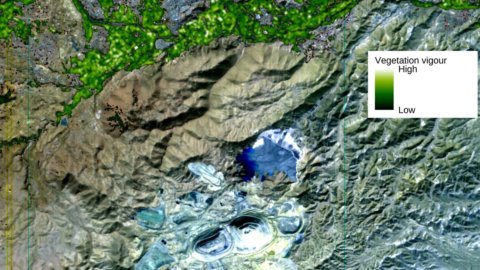Transparency of waters, state of health of crops, drought and fire risk, air pollution: the Italian Space Agency (ASI) presented new images from the Prisma satellite, able to shed light on the state of health of our planet and of contribute to the achievement of the sustainable development goals (SDG) of the United Nations. Thanks to the hyperspectral sensor, the first of its type ever launched in Europe and created by Leonardo, PRISMA thus proves to be a versatile guardian for protecting the environment. The spectacular photographs were captured in Italy, Peru and Iraq by the powerful hyperspectral sensor on board Prisma during the commissioning of the system.
Managed by the Fucino Space Centre, this phase allows testing of the satellite and its instrumentation through in-orbit tests, until the system is fully operational and its data available to the scientific community. The pictures were then received from the Matera Space Centre, where a team made up of specialized personnel from ASI, Leonardo, Planetek, Telespazio/e-GEOS and OHB Italia processed them with the support of scientists from IREA/CNR and the University of Milan, Bicocca. Launched into orbit on 22 March, Prisma, owned by ASI and created by a joint venture led by OHB Italia and Leonardo, is the first European Earth observation system equipped with an innovative hyperspectral optical sensor, capable of carrying out a chemical-physical analysis of the areas under observation.
The first, exciting mission results confirm the capabilities of the Italian space system, which has acquired a very important know-how, now available for future hyperspectral missions in Europe and in the world. The first image shows Trasimeno, the fourth largest lake in Italy, a natural basin of 128 km2. Its water resources are essential for tourism, agriculture and fishing. In less than 2 seconds, Prisma measured the turbidity at every point in the lake, noting the clearest waters and algae colonies. Water is the most precious resource, and its careful management, in line with the SDGs "clean water" and "life below water" represents, in an era of climate change, a fundamental commitment towards future generations. In Peru, Prisma measured the water content of crops, distinguishing well-watered fields from those affected by drought.
Sustainable agriculture is a great challenge for humanity: focusing on “zero hunger” and “sustainable production and consumption”, as indicated by the United Nations SDGs, Prisma allows unprecedented monitoring of water scarcity in vegetation, offering new tools to precision agriculture. Approximately 65.000 fires occur in Europe every year, 85% of which occur in the Mediterranean area. Prisma's water monitoring, applied to forests, can provide a precursor signal of fire risk: the third image shows us an example where the most advanced technology can be used to save human and animal lives, protect biodiversity and the soil from hydrogeological risks caused by fires.
In Castel Fusano (Rome), a naturalistic area endangered by frequent fires, Prisma conducted two analyses: the state of the vegetation, evaluating the chlorophyll content in the plants, and the water content in the various parts of the park, identifying the driest areas and therefore most at risk. The gas fires connected to the oil extraction in Basra (Iraq) were also filmed by Prisma. As well as the ability to accurately determine the extent of the fire, hyperspectral technology allows you to recognize chemicals generated by combustion: carbon dioxide (CO2) and other hydrocarbons have their own hyperspectral fingerprint and Prisma is able to measure it by characterizing atmospheric pollution.
Prisma reveals all its capabilities in monitoring the delicate terrestrial ecosystem: it recognizes not only the conditions of the water and soil all over the world, but also the state of the atmosphere and the chemicals that populate it, which is extremely useful in case of natural disasters. The exciting images presented today offer a taste of what the satellite can deliver when it is fully operational: a huge contribution to pollution control and environmental changes, a fundamental support for the management of natural resources and emergencies.




